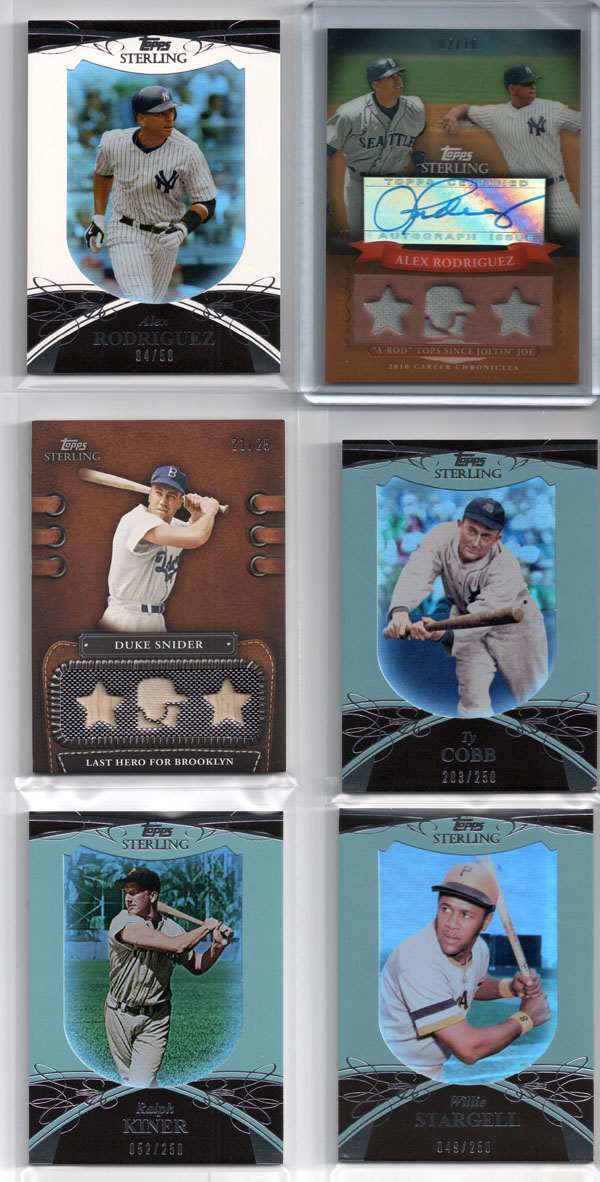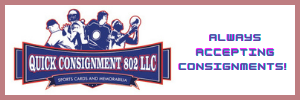
2010 Topps Sterling Review
Good: inventive pack themes, fantastic packaging (fancy plastic box), great checklist, classy product, geared toward hardcore baseball fans, captures the essence of America's past time well, players from all eras
Bad: small relics, boom or bust boxes, expensive, somewhat boring base cards, card design lacks finishing touch at times, autographs harder to come by than one would expect
Card Design: 3.5/5
The card design is slightly above average as a whole. The base cards looks a tad too similar to other high-end Topps products I've seen over the years. The relics can look a bit tacky at first, but they grow on you after a couple of days. The coolest cards in the product are the hard to pull book cards, which feature an array of intriguing player combinations (Jason Heyward/Dave Winfield) as well as a host of crazy relics and autos.
What makes this such an intriguing product are the players featured on the cards and the themes used to tie baseball history together. The card design takes a back seat to other aspects of the product at the end of the day.
Checklist: 4.75/5
The checklist is where Sterling truly shines, it's tight, precise and tells the 100+ year story of baseball on cardboard. From Ty Cobb to Babe Ruth to Mickey Mantle to Rod Carew to Nolan Ryan to Greg Maddux to Jason Heyward, Sterling covers all the bases of baseball history. The "themes" used for each pack are as impressive as the product's player selection. Basically, each box features a theme. For instance, my box was "Three Home Run Games", hence each card featured a player that has accomplished that feat.
Value: 4/5
The value is hit or miss like the majority of high-end sports card offerings. It's a risky proposition to spend over $200 on any box, but Sterling is the type of product that could very well deliver the hit of lifetime. When it comes to other 2010 high-end baseball products, Sterling is a far greater value than 2010 Topps Tribute and though I might be in the minority on this, I think it's a better product than 2010 Triple Threads.
Much of Sterling's value can't be described monetarily, as the experience of opening a box is part of the product's appeal and overall value. If you collect for profit, this product probably isn't for you. But if you collect because you enjoy cards, it's definitely worth opening a box or two if you can afford to.
Fun Factor: 4.75/5
As a hardcore baseball fan, I found Topps Sterling extremely fascinating and intriguing. Sterling is definitely an authentic sports card experience from start to finish. There's something really cool about opening a hard plastic box that seems better suited for a jewelry store than a card store.
I imagine that Bill James (father of sabermetrics) would thoroughly enjoy ripping this product, as the themes used to connect baseball history are extremely impressive. There's an x-factor to this product that I can't put my finger on, it's almost like you've purchased your very own one of kind chapter in baseball history. I don't open high-end products very often, but I enjoyed Sterling far more than 2010 Topps Tribute and 2010 Topps Triple Threads.
The Bottom Line: 4.3/5
Topps Sterling is the sweeping tale of the game of baseball told trough cardboard. If you fancy yourself a baseball historian, this is a product you will definitely want to check out if you can afford the steep box price of around $200-$220.
Each box delivers one 5-card pack and a 1-card bonus pack. Sterling's pack themes are extremely well done and connect numerous eras together in a "Bill James-esque" fashion. If prospecting is the name of your collecting game, this isn't the product for you, but if you're an old school baseball fan, Sterling is something you'll definitely want to check out. Sterling is a baseball fans' baseball card product.
 | Making purchases through affiliate links can earn the site a commission |





























Jay Berg
Are the relics really gamed used by the player on the card. I ask because the disclaimer on the backs say:
1. In prominent print that the card contains pieces of game used memorabilia.
2. A few lines of text later and in much smaller print is the following legalesque “disclaimer” :
“The relics contained in this card are not from any particular game, event or season”
I find it rather odd that this disclaimer is not only included, but how it is written as well as appearing in the “fine print.”
Although one would assume this is game used by the player on the card, language affirming this is not used. Instead Topps says it is game used memorabilia who knows when. It is as if they were very careful NOT to say that the memorabilia was game used by the player featured in the card. To me, that is very odd.
Topps could have included language certifying the authenticity of the relic as being used by the player, but they don’t. Something just doesn’t seem right.
Can anyone shed more light on why Topps uses such careful wording? Technically, what is written provides an opening to use “relic” materials from any game by any player. That is all Topps is certifying. Furthermore, the definition of what qualifies as a “relic” is in the eye of the reader. There is no industry definition or guidelines for what materials are relics. The word “relic” implies it’s old, but does not mean that.
…would love hear from others, especially any lawyers knowledgeable about deceptive trade practices or creating a self regulatory organization charged with creating uniform guideline for the industry on issues such as this.
Ryan Cracknell
Jay Berg � This was brought up at a session at the National a few days ago. They said part of the reasoning is that a card may have several different pieces for any given card (ie, started with a jersey and ran out so moved onto a bat, etc). It was brought up the wording was poor and they said they’d look into it.